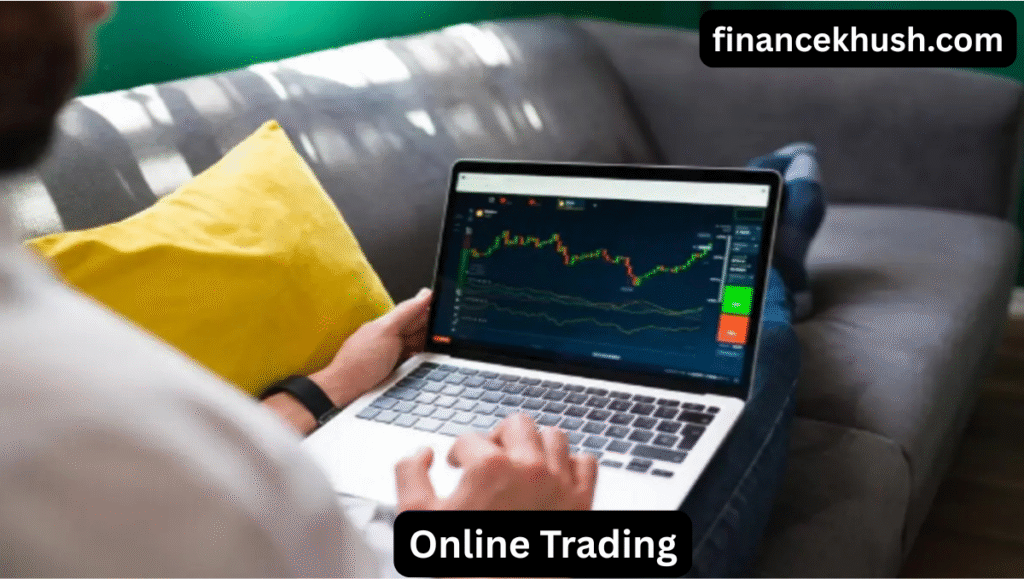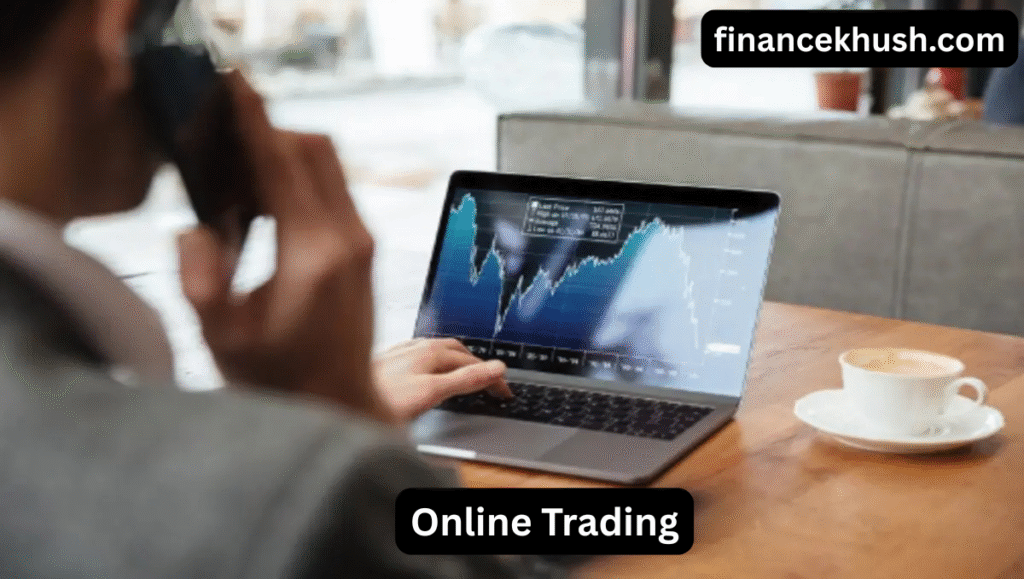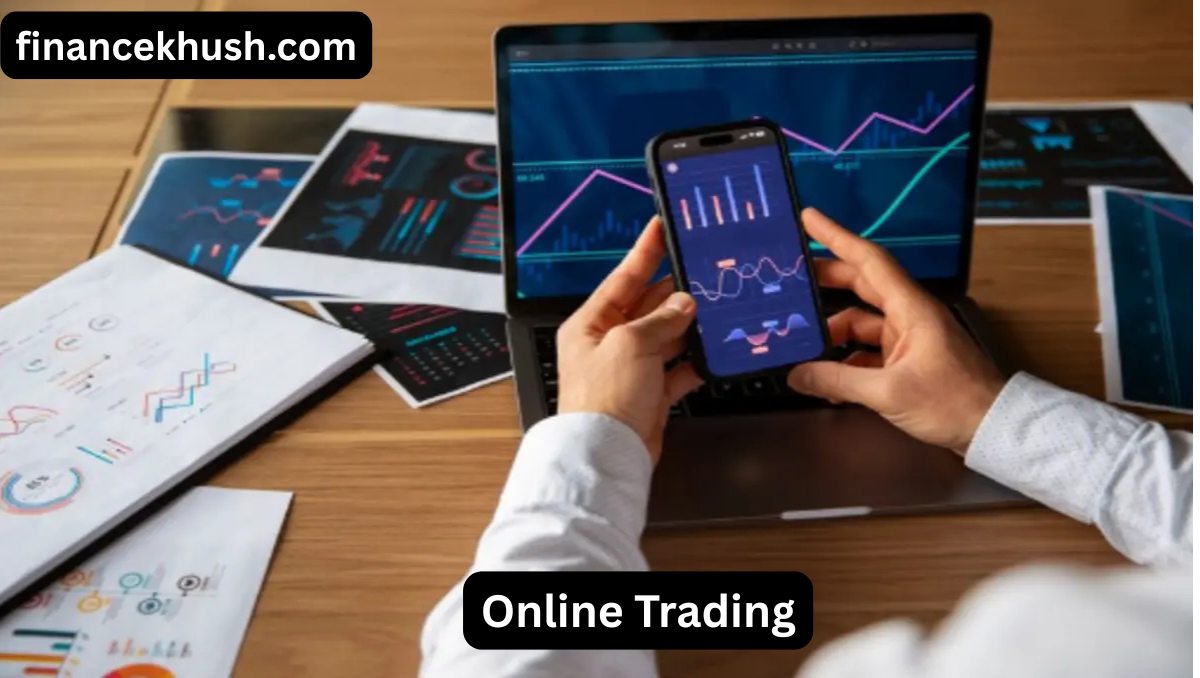Online Trading has opened doors to countless opportunities for individuals looking to grow their wealth from the comfort of their home. Whether you’re interested in stocks, cryptocurrencies, or forex, online trading makes it easy to dive into the world of investments with just a few clicks. In this beginner-friendly guide, we’ll break down the basics of online trading, show you how to choose the right platform, and share tips on strategies for success. You don’t need a finance degree to get started—just the right knowledge and tools. Get ready to learn how to trade smart, manage risk, and make informed decisions that could set you on the path to financial growth.
What is Online Trading?
At its core, online trading refers to buying and selling financial products like stocks, bonds, forex, and commodities via the internet. Rather than relying on a traditional stockbroker or financial institution to execute trades on your behalf, online trading allows you to directly place trades through trading platforms or brokerage accounts.
This form of trading became widely accessible in the late 1990s when the internet started revolutionizing the financial markets. Today, millions of people around the world engage in online trading, using various platforms and strategies to take advantage of market movements.
Types of Online Trading
There are several types of online trading, each catering to different kinds of investors and traders. Here’s a quick overview of the most popular types:
1. Stock Trading
Stock trading is perhaps the most popular form of online trading. In stock trading, you buy shares of companies that you believe will increase in value. When the price of the stock goes up, you can sell your shares for a profit. Stock trading can be done on various platforms like E*TRADE, TD Ameritrade, or Robinhood.
2. Forex Trading
Forex, or foreign exchange, involves trading currencies. The forex market is one of the largest financial markets in the world, with daily trading volume exceeding $6 trillion. Forex trading is usually done in currency pairs, like EUR/USD or GBP/JPY, and traders aim to profit from fluctuations in exchange rates.
3. Commodity Trading
Commodities are raw materials or primary agricultural products, such as gold, oil, and wheat. Commodity trading allows investors to profit from price fluctuations in these essential goods. Traders can invest in commodities directly through futures contracts or via exchange-traded funds (ETFs).
4. Cryptocurrency Trading
With the rise of digital currencies like Bitcoin, Ethereum, and others, cryptocurrency trading has become a hot topic in the world of online trading. These digital currencies are traded on specialized exchanges such as Coinbase, Binance, or Kraken. Cryptos can be volatile, offering high-risk but also high-reward opportunities for traders.
5. Options and Futures Trading
Options and futures are contracts that give traders the right (but not the obligation) to buy or sell an asset at a specified price by a particular date. While these instruments are more complex than buying and selling stocks, they provide a way to leverage capital and potentially make higher returns. However, they also come with a greater risk of loss.
Getting Started with Online Trading
Now that you have an overview of the types of trading, let’s talk about how you can get started in online trading. Here’s a simple step-by-step guide to help you dive in:
1. Choose a Trading Platform
The first thing you’ll need to do is choose a trading platform or brokerage account to start trading. The platform you choose will depend on your preferred type of trading and the features you need.

Some popular online trading platforms for beginners include:
- Robinhood: Great for beginners who want to trade stocks, ETFs, and options without paying commissions.
- TD Ameritrade: Known for its educational resources and excellent trading tools for stocks, options, and futures.
- E*TRADE: Offers a wide variety of investment options and user-friendly tools.
- Coinbase: The go-to platform for buying, selling, and holding cryptocurrencies.
When selecting a platform, consider factors such as fees, ease of use, educational resources, and the variety of assets available for trading.
2. Fund Your Account
Once you’ve signed up with a trading platform, you’ll need to fund your account. Most platforms allow you to link your bank account to transfer money easily.
It’s important to start with an amount that you’re comfortable with. Remember, online trading involves risk, so you shouldn’t invest more than you can afford to lose, especially when you’re just starting out.
3. Research and Learn
Before jumping into the market, it’s important to do your homework. Learn as much as you can about the assets you’re interested in trading. The more knowledge you have, the better equipped you’ll be to make informed decisions.
You can find many educational resources on platforms like:
- YouTube tutorials
- Blogs (like this one!)
- Online courses
- Podcasts
- Trading communities
By learning from experienced traders and experts, you’ll begin to build a solid foundation of trading knowledge.
4. Start Small
When you’re just starting out, it’s a good idea to begin with a small amount of capital. While it might be tempting to dive in big, starting small will help you minimize potential losses and give you time to learn how the markets work without risking too much.
5. Practice with a Demo Account
Many trading platforms offer demo accounts where you can practice without using real money. Demo accounts are an excellent way to familiarize yourself with the platform, experiment with strategies, and understand how market movements affect your trades.
Trading Strategies
While there’s no one-size-fits-all approach to online trading, there are several common strategies that traders use. Here are a few you might encounter:
1. Day Trading
Day trading involves buying and selling assets within the same day. Day traders aim to profit from small price movements throughout the day. This strategy requires a lot of time, attention, and expertise, as markets can fluctuate rapidly.
2. Swing Trading
Swing trading is about holding onto assets for a few days or weeks, aiming to profit from larger price swings. Swing traders use technical analysis to identify trends and buy and sell accordingly. This strategy tends to be less intense than day trading.
3. Scalping
Scalping is one of the most fast-paced strategies in online trading. Scalpers aim to make small profits on many trades throughout the day. They typically hold positions for just a few seconds or minutes. While this strategy can be highly profitable, it requires sharp skills and fast decision-making.
4. Long-Term Investing (Buy and Hold)
Not everyone wants to trade actively every day. Some traders prefer the “buy and hold” strategy, where they purchase assets with the intention of holding onto them for months or even years. This strategy is generally less stressful and works well for those who believe in the long-term growth of certain companies or assets.
Risk Management in Online Trading
While online trading can offer great potential rewards, it’s important to acknowledge the risks involved. Markets can be volatile, and it’s possible to lose more than you invest if you’re not careful.
Here are some key risk management tips:
1. Use Stop-Loss Orders
A stop-loss order is a tool that automatically closes your position if the asset price drops to a certain level. This helps minimize potential losses by preventing you from holding onto a losing trade for too long.
2. Diversify Your Portfolio
One of the best ways to manage risk is through diversification. By spreading your investments across different assets or sectors, you reduce the risk of a single asset causing significant damage to your portfolio.
3. Don’t Over-leverage
Leverage allows you to borrow money to increase the size of your trades, but it also increases the risk of significant losses. As a beginner, it’s wise to avoid using high leverage until you gain more experience.
4. Set Realistic Expectations
Online trading isn’t a get-rich-quick endeavor. You won’t always make money, and it’s crucial to be realistic about your goals. Successful traders often see consistent, small profits over time, rather than massive gains from a single trade

Conclusion
Online trading is an exciting and potentially lucrative way to engage with financial markets. However, it’s not without its challenges. By understanding the basics, choosing the right platform, and using sound trading strategies, you can increase your chances of success.
Remember, the key to becoming a successful online trader is education and experience. Start small, learn from your mistakes, and keep practicing. Over time, you’ll develop the skills necessary to navigate the markets confidently.
Related post
Here are top 6 best faq’s
1. What is Online Trading?
Online trading is simply the process of buying and selling financial assets like stocks, bonds, and cryptocurrencies through internet-based platforms. Instead of using a broker to execute trades for you, you use a trading app or website to manage your investments directly from your computer or phone. It’s fast, accessible, and allows you to trade at your convenience.
2. How Do I Get Started with Online Trading?
Getting started is easier than you might think! First, you’ll need to choose a reliable trading platform, like Robinhood, E*TRADE, or Coinbase. After that, fund your account with some money, and you’re ready to start exploring. It’s a good idea to begin with small investments and practice with demo accounts to get the hang of things before jumping into real trades.
3. Is Online Trading Safe?
Yes, online trading is generally safe as long as you use trusted platforms and take necessary precautions. Make sure your trading account is secured with strong passwords and two-factor authentication. Do some research on the platform’s reputation and fees to ensure it aligns with your needs. But like any investment, there’s always a risk involved, so it’s important to trade wisely.
4. How Much Money Do I Need to Start Trading?
You can start online trading with as little as $1, depending on the platform and the type of asset you’re trading. However, it’s important to start with an amount you’re comfortable losing, as trading can be unpredictable. Many beginners start with $100 to $500 to get familiar with the process without risking too much.
5. What’s the Best Strategy for Beginners?
As a beginner, it’s smart to start slow and focus on long-term investing or swing trading rather than day trading. Long-term investing involves buying assets you believe in and holding onto them for months or years, while swing trading involves taking advantage of short-term market movements. Don’t rush—learn as you go and stick with simple strategies at first.
6. Can I Trade on My Phone?
Absolutely! Many online trading platforms offer mobile apps that let you trade anytime, anywhere. You can buy and sell assets, track your portfolio, and even set alerts for price changes—all from the convenience of your smartphone. It’s perfect for busy traders who want to stay on top of their investments.

1 thought on “Online Trading: How to Invest Smarter and Grow Wealth 2025”